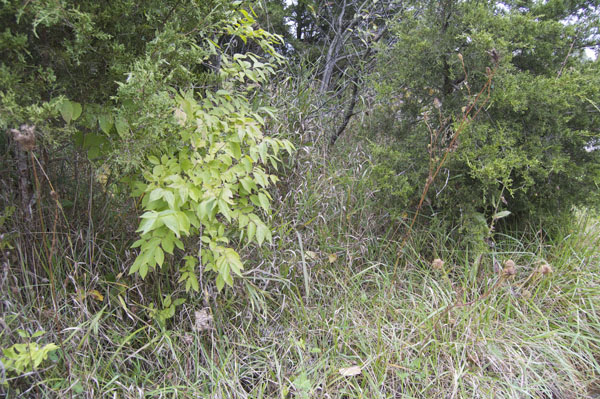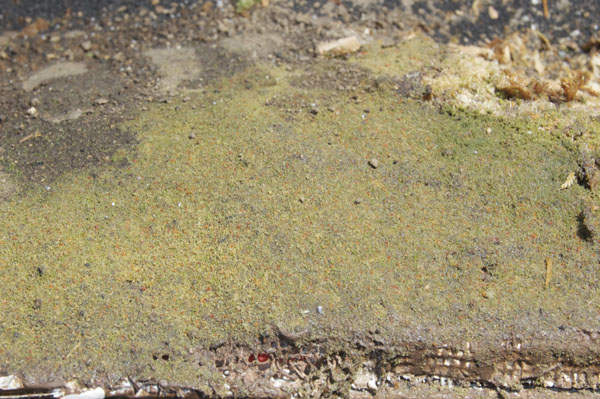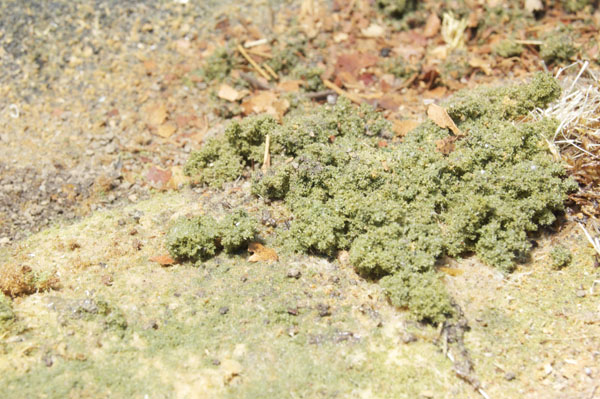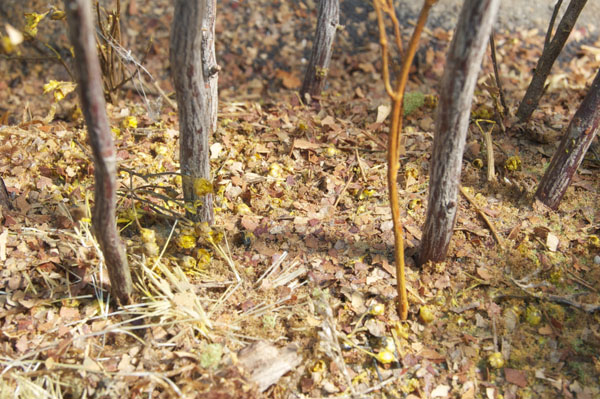One of the easiest improvements to make in modeling landscapes is to pay closer attention to the amazing variety of plant textures in the real world (Photo 1).
Here we see just how profuse nature can be, and this is really a pretty tame example. In the foreground we have overgrown grasses, with some broadleaf plants gaining a foothold. Moving towards the back, larger shrubs and small trees begin to dominate. Notice how the bright leaved sapling to the left encroaches on the cedar tree next to it. Notice too, how tall the grasses are in the sheltered area between the trees. Seriously people, do we even think about modeling things like this? No. Here’s what we do (Photo 2).
Here’s your typical ground foam excuse for grass. It looks more like moss to my eyes, especially in 1/4″ scale. Maybe it’s the fairway on the local golf course. It certainly doesn’t resemble anything in the prototype photo above. If a modeler is really bold however, he’ll add a few weeds or shrubs because that’s what all the books say to do (Photo 3).
Now we’re getting somewhere! Right? Maybe in HO or N scales where these bits of green sofa cushion would represent larger plants. Again, this is a 1/4″ scale landscape and you need to keep the relative size differences firmly in mind. What works in the smaller scales will not look as good here, especially when we introduce objects like the trains or figures whose size is easy to determine. To my eyes, where these commonly used materials fail miserably is in their lack of textural variety. They are too small to represent what they’re supposed to be in a larger scale. We need to rethink our assumptions (Photo 4).
In an earlier post titled Learning to see, I introduced the idea of concepts and how easy it is to fall prey to preconceived ideas about how things look. Just as with trains or trees, we need to look at all aspects of a model landscape with open minds and eyes, lest we fall into the traps shown in Photos 2-3. How do we do this? By deliberately forgetting what we think we know about “scenery” and opening our eyes to what the real world has to teach us. Most wouldn’t think to model a locomotive of any kind without some sort of prototype to follow for dimensions, general arrangement of wheels, appliances and so on; yet we’ll sprinkle green fairy dust ground foam all over the place with impunity and call it grass. It’s time to stop this madness and treat the model landscape as carefully as we treat a freight car model. Look at Photos 3 – 4 and you judge for yourself which one would enhance the train more. Here’s another example from the front of my layout (Photo 5).
Some people have the mistaken thought that super detailed scenery takes away from the trains. In my view, highly detailed scenery enhances a model more than anything else you could do to it. Placing a well detailed freight car in an equally detailed scene completes the picture we’re all trying to paint. A model sitting on bare plywood lacks realism, I don’t care how finely detailed or accurate it is. The real world context that we view the prototype in will be missing. Don’t think that matters? Which is better, a pristine locomotive sitting indoors in a sterile museum environment or on the ready tracks at a terminal where it belongs?
Now, if you’re an absolute beginner who has never done any kind of scenery, you’re forgiven. And, if ground foam and the traditional ways are your deliberate choice, that’s fine by me. You’re excused from class. IF, however, you’ve reached a stage in your modeling where you’re ready to move beyond generic scenery materials and learn something new, then start looking at the world around you with an eye toward seeing what is really there. Hint, it didn’t come out of a bag.
Regards,
Mike





“Model what you see” should be a mantra!
Love photos 4 and 5, in New Jersey right now the ability to model Fungi is a must.
Keep up the good work…….Pete.
Thank you Pete. Welcome abroad. We’re glad you’re here. Yes, it’s been a bit soggy for you folks this year hasn’t it?
Regards,
Mike